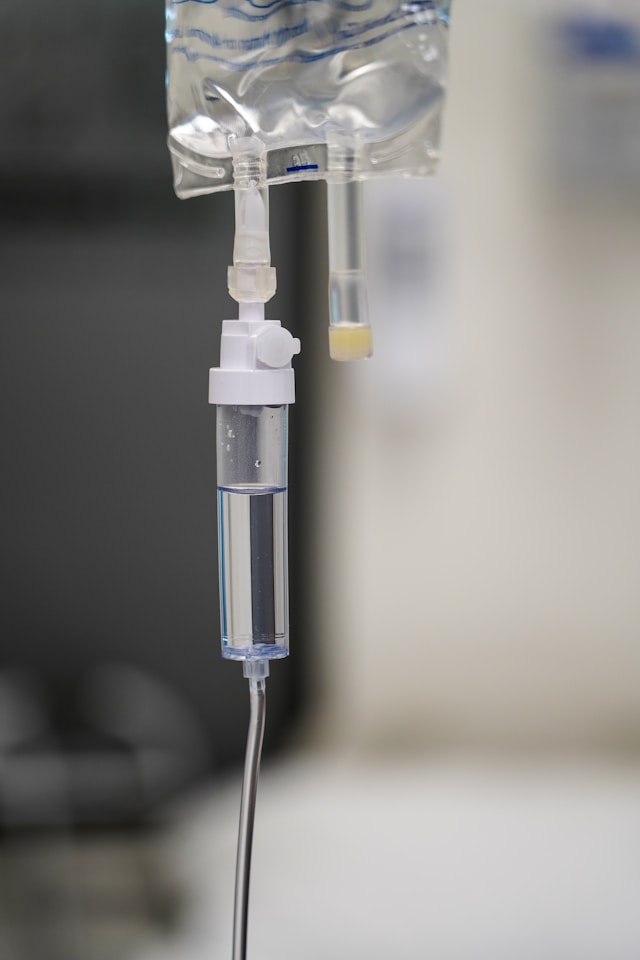
Ocrevus (Ocrelizumab) Infusions Explained


Dr. Chen is a board-certified immunologist with over 15 years of experience treating autoimmune and immunodeficiency disorders. She specializes in IVIG therapy and has published extensively on immune system treatments.
Medical Disclaimer
Ocrevus (ocrelizumab) is a breakthrough medication for multiple sclerosis, offering powerful disease control with convenient twice-yearly dosing. As a CD20 monoclonal antibody that depletes B cells involved in MS inflammation, Ocrevus is the only FDA-approved treatment for both relapsing MS and primary progressive MS. Understanding how Ocrevus works, what to expect during infusions, and how to optimize treatment helps you navigate this important therapy for managing MS.
Key Highlights
- Ocrevus depletes CD20-positive B cells that contribute to MS inflammation, reducing relapses by approximately 46% and slowing disability progression.
- After initial treatment (two half-doses 2 weeks apart), Ocrevus is given as a single infusion every 6 months, offering convenient twice-yearly dosing.
- Ocrevus is the only disease-modifying therapy approved for primary progressive MS, making it essential for patients with this form of the disease.
What Is Ocrevus
Ocrevus (ocrelizumab) is a monoclonal antibody designed to target and bind to CD20, a protein found on the surface of certain B cells (a type of white blood cell). By binding to CD20, Ocrevus marks these B cells for destruction by your immune system, temporarily depleting them from circulation.
While MS was traditionally considered primarily a T-cell mediated disease, research has revealed that B cells also play crucial roles in MS inflammation and progression. B cells contribute to myelin damage through multiple mechanisms including antibody production, cytokine secretion, and antigen presentation. By depleting these harmful B cells, Ocrevus reduces MS disease activity.
Ocrevus was approved by the FDA in 2017 and has since become one of the most commonly prescribed MS medications. According to the National Multiple Sclerosis Society, Ocrevus represents a major advance in MS treatment, particularly for primary progressive MS patients who previously had no approved disease-modifying therapy.
Conditions Treated with Ocrevus
Ocrevus is FDA-approved for multiple sclerosis:
Relapsing Forms of MS: Including relapsing-remitting MS and active secondary progressive MS with relapses. Ocrevus significantly reduces relapse rates and slows disability progression.
Primary Progressive MS: The only disease-modifying therapy approved for PPMS. Clinical trials showed Ocrevus slows disability progression in PPMS patients, offering hope for a patient population that previously had no approved treatments.
Ocrevus is not approved for other conditions, though the related medication Rituxan (rituximab), which works similarly, is used for various autoimmune and hematologic conditions.
How Ocrevus Works
CD20 is a protein expressed on pre-B cells and mature B cells, but not on stem cells or plasma cells. When Ocrevus binds to CD20-positive B cells, it triggers several mechanisms that destroy these cells:
Antibody-Dependent Cell-Mediated Cytotoxicity: Your immune system's natural killer cells recognize Ocrevus-coated B cells and destroy them.
Complement-Dependent Cytotoxicity: The complement system (part of your immune system) is activated against Ocrevus-coated B cells, leading to their destruction.
Direct Apoptosis: Ocrevus binding may trigger programmed cell death in some B cells.
The result is significant depletion of CD20-positive B cells, which reduces the inflammatory attack on myelin in MS. Importantly, stem cells and plasma cells (which produce antibodies for long-term immune memory) are preserved, maintaining some immune function.
According to the Mayo Clinic, B cell depletion with Ocrevus provides powerful MS disease control while allowing eventual B cell recovery between doses.
Ocrevus Dosing and Schedule
Initial Treatment:
- First infusion: 300 mg infused over approximately 2.5 hours
- Two weeks later: Second 300 mg infusion over approximately 2.5 hours
- Total initial dose: 600 mg divided into two infusions
Maintenance Treatment:
- Every 6 months: Single 600 mg infusion over approximately 3.5-4 hours
- Continues indefinitely as long as treatment remains effective and tolerated
Why Split Initial Dose: Dividing the first 600 mg dose reduces infusion reaction risk. After your body adjusts during the first two infusions, subsequent single 600 mg infusions are better tolerated.
Twice-Yearly Convenience: Every-6-month dosing is one of Ocrevus's major advantages over medications requiring monthly infusions or daily/weekly self-administration.
What to Expect During Ocrevus Infusions
Pre-Treatment Screening: Before starting Ocrevus, you'll need baseline MRI, blood work (complete blood count, liver function, immunoglobulin levels), hepatitis B screening (Ocrevus can reactivate hepatitis B), and assessment of vaccination status. Complete recommended vaccinations at least 6 weeks before starting Ocrevus.
Pre-Medications: All patients receive pre-medications about 30-60 minutes before Ocrevus to reduce infusion reaction risk:
- IV methylprednisolone (corticosteroid): 100 mg
- Antihistamine (oral diphenhydramine or equivalent)
- Acetaminophen or ibuprofen: 500-1000 mg
These pre-medications significantly reduce infusion reaction frequency and severity.
First Infusion (300 mg): Your initial Ocrevus infusion starts very slowly with careful rate escalation. The 300 mg dose typically takes about 2.5 hours plus pre-medication time and post-infusion monitoring. Total appointment time is usually 4-5 hours. Bring entertainment, snacks, comfortable clothing, and anything to make the time comfortable.
Second Infusion (Two Weeks Later, 300 mg): Similar to the first but often better tolerated. Some patients experience fewer reactions on the second infusion.
Subsequent 600 mg Infusions (Every 6 Months): After the initial two-dose series, you'll receive full 600 mg doses every 6 months. These typically take 3.5-4 hours. Once you've tolerated several infusions without reactions, the infusion time may potentially be shortened. Total appointment time is usually 5-6 hours.
During Infusion: You'll be monitored throughout with periodic vital sign checks. Most patients read, work on laptops, watch videos, or rest during their infusion. Many infusion centers have comfortable recliners, Wi-Fi, and amenities.
Post-Infusion Monitoring: You'll remain for at least one hour after infusion completion to ensure no delayed reactions occur. This monitoring period is essential, particularly for first infusions.
Timeline for Benefit
Reducing Relapses: The goal is preventing future MS relapses rather than immediately reversing existing symptoms. Many patients go months to years without experiencing MS relapses on Ocrevus.
MRI Activity: New or enlarging brain lesions on MRI typically decrease significantly or stop entirely within 6-12 months of starting Ocrevus, indicating reduced disease activity.
Disability Stabilization: Slowing disability progression is gradual. You may not feel dramatically different initially, but over months to years, Ocrevus helps maintain function you might have otherwise lost.
Symptom Stability: Many existing MS symptoms stabilize or improve slightly, though significant reversal of longstanding disability is uncommon.
Benefits of Ocrevus
Patients on Ocrevus often experience:
Dramatically Reduced Relapse Rates: Clinical trials showed 46-47% reduction in relapses compared to interferon therapy. Many patients remain relapse-free for years.
Slowed Disability Progression: Significant reduction in disability worsening, helping patients maintain function longer.
Reduced MRI Activity: Fewer new or enlarging brain lesions, indicating better disease control.
Convenient Dosing: Twice-yearly infusions are far more convenient than daily pills, weekly injections, or monthly infusions.
Treatment for PPMS: For primary progressive MS patients, Ocrevus offers the only approved disease-modifying therapy, providing hope where none existed previously.
Potential for NEDA: Some patients achieve "no evidence of disease activity" (NEDA)—no relapses, no new MRI lesions, no disability progression—for extended periods.
Quality of Life: Better disease control allows many patients to work, maintain independence, and participate in life activities longer.
The American Academy of Neurology recognizes Ocrevus as a high-efficacy treatment for MS with favorable benefit-risk profile.
Potential Side Effects and Risks
Infusion Reactions: The most common side effect, occurring in about 34-40% of patients during first infusions but decreasing to 10-25% with subsequent infusions. Symptoms include itching, rash, throat irritation, flushing, fever, fatigue, headache, dizziness, nausea, rapid heartbeat. Most reactions are mild to moderate and respond to slowing infusion rate or temporarily stopping and restarting. Pre-medications significantly reduce reaction frequency.
Increased Infection Risk: B cell depletion increases susceptibility to infections. Upper respiratory infections, urinary tract infections, and herpes virus reactivation are more common. Serious infections occur in a small percentage of patients. Report fevers, persistent cough, or concerning symptoms promptly.
Decreased Immunoglobulin Levels: Long-term Ocrevus can lower IgG and IgM levels in some patients, further increasing infection risk. Regular monitoring identifies this, and some patients may benefit from immunoglobulin replacement if levels drop significantly.
Hepatitis B Reactivation: Patients with current or past hepatitis B infection can experience virus reactivation with B cell depleting therapy. Screening before treatment and monitoring are essential.
Progressive Multifocal Leukoencephalopathy (PML): This rare, serious brain infection caused by JC virus has occurred in a very small number of Ocrevus patients. Risk appears lower than with some other MS therapies but monitoring for PML symptoms (confusion, cognitive changes, vision changes, weakness) is important.
Breast Cancer: A numerical imbalance in breast cancer cases was observed in Ocrevus clinical trials compared to control groups. Whether this represents true increased risk or statistical chance remains uncertain, but breast cancer screening is important for women on Ocrevus.
Vaccination Response: B cell depletion may reduce response to vaccinations. Complete recommended vaccines before starting Ocrevus. Live vaccines should be avoided during treatment and for at least 6 months after last infusion.
Your neurologist monitors for these issues through regular appointments, periodic blood work, and symptom assessment.
Living with MS on Ocrevus
Infection Prevention: Practice careful hand hygiene, avoid sick contacts when possible, stay current on recommended non-live vaccines (given before treatment or between infusions when B cells have partially recovered), report infections promptly.
Treatment Adherence: Keep your twice-yearly infusion appointments consistently. Extended intervals between Ocrevus doses may increase disease activity risk and could potentially increase infusion reactions when treatment resumes.
Monitoring: Attend regular neurology appointments, complete recommended MRI scans (typically annually), and have periodic blood work checking immunoglobulin levels and blood counts.
Healthy Lifestyle: Continue MS-friendly habits—appropriate exercise, healthy diet, adequate sleep, stress management, avoiding smoking, heat management.
Breast Health: Women should perform regular breast self-exams and maintain age-appropriate mammography screening.
Vaccination Planning: Complete any needed vaccinations before starting Ocrevus or during extended intervals when B cells have recovered. Discuss timing with your neurologist.
Cost and Insurance Considerations
Ocrevus is expensive, with each 600 mg infusion costing approximately $65,000:
Insurance Coverage: Most plans cover Ocrevus for MS with prior authorization. Some require trying less expensive therapies first (step therapy), though neurologists can often successfully appeal this for appropriate patients.
Medicare Coverage: Medicare Part B covers Ocrevus infusions for MS. Beneficiaries typically pay 20% coinsurance after meeting Part B deductible.
Copay Assistance: Genentech (Ocrevus manufacturer) offers robust copay assistance through the Ocrevus Co-pay Program, potentially reducing out-of-pocket costs to $0 for eligible commercially insured patients.
Patient Assistance: For uninsured or underinsured patients, Genentech offers patient assistance programs providing Ocrevus at no cost for those meeting income criteria.
Frequently Asked Questions
How effective is Ocrevus for MS?
Ocrevus is highly effective for MS. For relapsing MS, clinical trials showed 46-47% reduction in relapse rates compared to interferon therapy and significant slowing of disability progression. For primary progressive MS, Ocrevus slowed disability progression by 24% compared to placebo—the first medication ever to show benefit in PPMS. About 47% of relapsing MS patients achieve "no evidence of disease activity" on Ocrevus. While individual response varies, Ocrevus represents one of the most effective MS treatments available.
How often do you get Ocrevus infusions?
After initial treatment (two 300 mg infusions 2 weeks apart), Ocrevus is given as a single 600 mg infusion every 6 months (twice yearly). This convenient dosing schedule is a major advantage for many patients. Maintaining the 6-month interval is important for consistent disease control, though small variations (a few weeks early or late) are generally acceptable if necessary.
What are the side effects of Ocrevus infusion?
The most common side effects are infusion reactions (itching, rash, throat irritation, fever, headache) occurring in 34-40% of first infusions but decreasing with subsequent treatments. Increased infection risk is also common—upper respiratory infections, UTIs, and herpes reactivation occur more frequently. Some patients develop low immunoglobulin levels with prolonged treatment. Rare but serious risks include PML (extremely rare brain infection) and possible breast cancer risk. Most patients tolerate Ocrevus well, especially after first infusions.
Can you switch from Tysabri to Ocrevus?
Yes, switching from Tysabri to Ocrevus is common, particularly for patients who develop positive JC virus antibodies (increasing PML risk with Tysabri) or who prefer less frequent dosing. A washout period of 4-12 weeks between last Tysabri infusion and first Ocrevus infusion is typically recommended to reduce risk of excessive immunosuppression while minimizing risk of disease rebound. Your neurologist will determine appropriate timing based on your disease activity and PML risk.
Does Ocrevus work for primary progressive MS?
Yes, Ocrevus is the only FDA-approved disease-modifying therapy for primary progressive MS. Clinical trials showed Ocrevus slowed disability progression by 24% in PPMS patients compared to placebo. While this may seem modest, it represents meaningful benefit for a patient population that previously had no approved treatment options. Ocrevus appears most effective in younger PPMS patients with shorter disease duration and evidence of inflammatory activity on MRI.
Hope for Better MS Control
For many MS patients, Ocrevus has provided powerful disease control with convenient twice-yearly dosing. Whether you have relapsing MS or primary progressive MS, Ocrevus offers one of the most effective treatments available to slow disease progression and reduce relapses.
While MS remains a challenging condition, modern high-efficacy therapies like Ocrevus have dramatically improved outcomes, allowing many patients to maintain function and quality of life for years.
Ready to find an infusion center for your Ocrevus therapy? Explore infusion providers near you experienced in administering Ocrevus and supporting MS patients.
Medical Disclaimer: This content is for educational purposes only and is not a substitute for professional medical advice, diagnosis, or treatment. Always consult your healthcare provider with questions about your medical condition or treatment options.
Article Statistics


Table of Contents
Article Statistics










